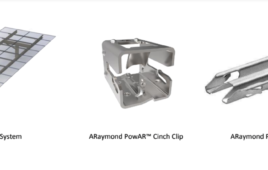Although there are a multitude of vertical-only spring contacts already on the market for electronic devices, components that can also support horizontal operation are less common. However, the demand for higher-density electronic designs means that engineers need greater flexibility with regard to how boards are connected together – and this is why support for multi-directional operation is attractive.

Click here for a product specs and summary.
To this end, Harwin is expanding its range of spring contacts with the addition of two new versions. These surface-mount components are capable of supporting horizontal and vertical connection orientations, but come in smaller size formats than were previously available.
The S1961-46R has a 3.55mm height, while the S1971-46R has a height of 4.55mm. The S1961-46R and S1971-46R offer current ratings of 14 Amps. This enables them to be used in low-level, power-delivery applications, as well as signal transfer and enclosure grounding tasks.
They also have a mating durability of more than 5,000 cycles. As connection is through touch rather than a wiping action, they have a greater operational life than horizontal tin-plated connectors.
“Our initial multi-directional spring contact offering proved very successful, as these components have been able to provide a much more flexible method for connecting PCBs to accommodate different arrangements,” explains Ryan Smart, NPI product manager at Harwin. “After their introduction, we received many requests from customers to develop more compact options, with smaller footprints and lower profiles. This has been the motivation behind our release of the S1961-46R and S1971-46R.”
These new items complement Harwin’s existing multi-directional spring contact products with larger form factors — the S1941-46R, S1941-42R, and the S1951-46R. As with all of Harwin’s spring contact products, the new units are supplied via tape-and-reel. Their surface mount design means they are suitable for automated assembly lines using pick-and-place machines.





Tell Us What You Think!